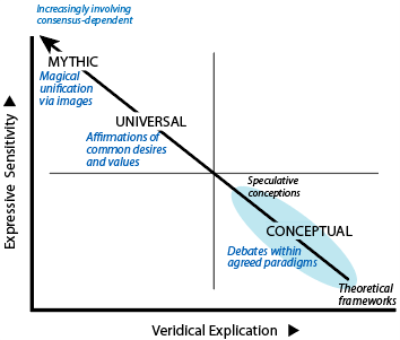Consensus Methods

Approach Duality
The as plotted on the TET evidently lie along two diagonals: see diagram.
As usual, the two sets of methods defined by the diagonals provide complementary properties and define the approach duality.
It seems that this duality covers the twin essences of communicative interaction: personal conviction and social consensus. This topic considers consensus. (See previous topic for conviction.)
Social Consensus
Approaches lying on the diagonal that goes from bottom right to top left are based in consensus amongst communicators and their audience. In order, they are:
↔ ↔
This is not to say that consensus prevails in general or in any specific communication. It is rather that consensus is a core underlying value and the presence of groups, communities or institutions desiring such consensus is a necessity for the sustenance of meaning.
Even in the presence of a dispute, the concern is for consensus in relation to communications. Sometimes there may be a desire to impose a consensus but this is a contradiction in terms. While individuals will have convictions in accord with the values they hold, the language they use on this diagonal is not primarily designed to express conviction.
In the approach, the communication must stay within a particular field where there is a social agreement as to the meaning assigned to key terms. That usually means education-socialization and membership of a particular association. Those concepts are then used to investigate and understand issues in the field. If a process of systematic inquiry evolves, with speculation debate and study, knowledge emerges and becomes established. The very word 'established' indicates the presence of a broad and deep social consensus.![]() More
More
In the approach, all language is shaped so that everyone feels they understand. Popular usage is a form of consensus on meaning that avoids precision and fosters a sharing of values. Social mood is intrinsically consensual, and even if irrational, tapping into that mood is commonly used to enhance receptivity. language can generate a sense of commonality and persuade individuals to act or think in a particular way. There may be cynicism in regard to the action or thought being pursued, so conviction is of no significance except in relation to speculation about the rhetoric, propaganda or sales pitch on offer.
In the approach, consensus around the image or around the significance of the text or the person giving the message is essential. When that is present, the communication galvanizes the audience and electrifies attention. Consider waving a national flag at a key moment in a political convention: the audience erupts. Burning the national flag, usually called desecration by those who get upset, can cause an uproar. Why does a national flag have this effect? It's a mystery that reflects the power of . If a newly created flag had been used instead, even with carefully chosen symbols, the audience would have been dumbfounded and mystified.
Increasing Involvement: Moving Up the Diagonal

The diagonal contains approaches that range from «low control of expression + high efforts to make sense» to «high control of expression + low efforts to make sense».
In other words, careful explication (on which individuals may disagree) becomes less important and sensitive expression (which can encompass all) becomes more important. So the methods are progressively more involving or less dispassionate and support unity.
- The method is about capturing ideas so that reality can be investigated. Individuals may take speculative positions or opposing sides in debates but they unite around agreed concepts and established knowledge.
- The method is about enabling and sustaining communities and societies. Communications must be able to handle many conceptual areas so that knowledge can be integrated and used. Unity is enhanced through affirming values and activating an associated emotional resonance.
- This method is abstract, mysterious and transcendental. It therefore has the potential to unite across societies, even to the whole of humanity.
- Consider the other diagonal set that focuses on conviction.
- Pairing methods by using both diagonals.
- Move to next analysis: quadrant differences.
Last draft: 27-May-2013. Amended: 4-Sep-2016. Last updated: 10 Feb-2023.